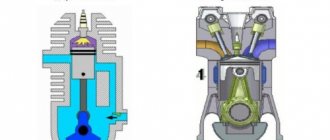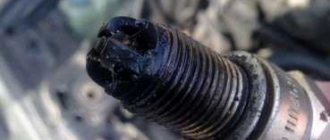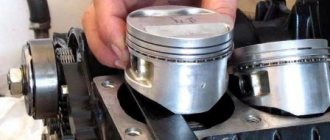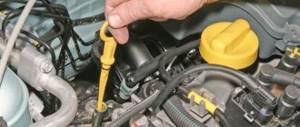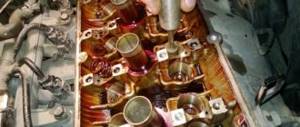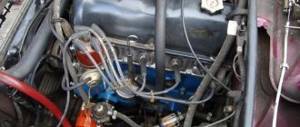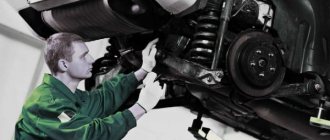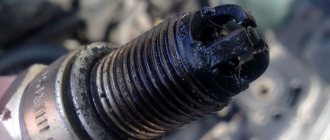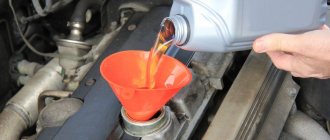What is soot?
Since the piston is the first part that takes the load from the ignition of the combustible mixture (takes the blow), it is constantly exposed to temperature, mechanical and chemical influences.
Soot is the formation of a layer as a result of burnt chemicals contained in the supplied fuel. Fuel contains various additives and impurities. When decomposed fuel substances come into contact with hot internal combustion engine parts (pistons, cylinders, valves, connecting rods), these substances stick to the hot metal and settle. Carbon deposits form especially quickly on the pistons due to incomplete combustion of the fuel-air mixture and the breakdown (decomposition) of engine oil. In other words, carbon deposits are deposits that interfere with the normal operation of the internal combustion engine, so it must be removed. Carbon removal is also called decarbonization.
The formation of carbon deposits on intake valves, piston heads, and walls of combustion chambers is the most common occurrence.
The composition of carbon deposits includes ash and carbon compounds. Solid deposits of ash + impurities and particles of unburned fuel and motor oil, also called coke. If there is a lot of coke on several parts, this is already coking of the engine.
Types of fuel injection in engines
The first type of injection is called distributed (denoted by the English abbreviation MPI).
The algorithm of its operation is that first the fuel is supplied to the engine intake manifold, where it is mixed with air. Next, the resulting air-fuel mixture is supplied to the engine cylinders, where it is subsequently burned. In this case, the so-called rinsing of the valves with the mentioned air-fuel mixture occurs. That is why carbon deposits do not form on the valves, since it is simply “carried away” during the passage of the mixture. Over time, of course, carbon deposits may form on such valves, but it depends on other factors. Firstly, from time. That is, the older the engine (or it has not undergone major repairs and/or valve cleaning for a long time), the higher the likelihood of carbon deposits forming. Secondly, carbon deposits in this case can be caused by a malfunction of the timing system; in particular, carbon deposits form if oil leaks through the valve seals. Then it will coke, which leads to the formation of carbon deposits on the valves.
Engine design with GDI direct injection
However, engines with so-called direct injection (denoted by the English abbreviation GDI) are more susceptible to large deposits on the intake valves. These engines are more modern and advanced compared to MPI, but one of their disadvantages is the formation of carbon deposits on their operating timing valves. Why is this happening? The GDI engine is designed to deliver fuel directly to the cylinders. This is achieved by the fact that the injector is located directly in the cylinder block. And only clean air is supplied through the intake manifold. Thus, mixing of fuel and air occurs directly in the engine cylinder itself.
It turns out that gasoline is supplied to the cylinders, bypassing the valves, and only an air flow passes through them, which is not able to remove (burn) the fuel deposit that forms on the valve body over time. This is the fundamental reason that on engines with direct injection, carbon deposits form on the intake valves much more often. Modern automakers are aware of this problem and are trying to solve it with design schemes. So, on many engines the fuel injector is located closer to the cylinder head, and sometimes even directly in the head. This allows you to increase the likelihood of gradually burning plaque, which subsequently turns into carbon deposits. However, in fairness, it is worth noting that such solutions do not help very well.
Methods for removing carbon deposits and coke
- Manual cleaning with disassembly.
- Cleaning with special solvents:
* through spark plug holes;
* through the oil filler neck.
To properly clean pistons from carbon deposits, you must use the manual mechanical cleaning method. If you choose this method, you will have to disassemble the engine and remove the pistons. This process is labor-intensive because you need a garage, knowledge and skill in disassembling the engine, and tools. After disassembly, clean the surface of the pistons with a scraper, then with sandpaper.
- The advantage of manual mechanical cleaning is high-quality removal of soot, coke, and varnish.
- The downside is time and labor.
Cleaning pistons from carbon deposits without disassembling.
Many people choose the second method of cleaning pistons from carbon deposits - without disassembling. When decoking and sticking of piston rings, a method is used without dismantling engine parts.
The principle of such cleaning is the use of special products that can dissolve the resulting coke and plaque.
Such coke solvents are poured directly through the holes for the spark plugs (through the holes for the glow plugs - for diesel units) or through the lubrication system (neck for filling engine oil). The liquid poured in should dissolve the black carbon deposits that have formed.
Advantages of decarbonization and removal of carbon deposits with a special liquid:
- easy and fast;
- The oil scraper rings will decarbonize.
Minuses:
- Carbon deposits are not removed from the surfaces of the working combustion chamber, pistons and valves;
- It will not cope with a heavily coked engine.
There are two types of cleaning and decoking:
- Soft. If you pour solvent through the spark plug holes, this method is called “hard” cleaning.
- Solid. If through the oil filling hole, this is a “soft” cleaning.
Soft decarbonization
The essence of this method is that before replacing the engine oil, a flushing liquid is poured into the engine with the effect of decoking the piston rings (for example, Liquid Moli, XADO / Xado).
When using this method, it is necessary to study the operating features of the engine after adding this liquid to the engine oil. As a rule, you should not put heavy loads on the engine (using a trailer, large luggage, slipping, exceeding average speed). This is due to the fact that the oil has become diluted and the physical and chemical characteristics of the oil have changed.
This cleaning method, that is, without disassembling the engine, but using a special liquid for decoking and removing carbon deposits from the CPG parts through the oil filler hole, should be used for prevention. Then there will be an effect.
Hard carbon removal
If deposits on the parts of the cylinder-piston group and valves are large, then you can use a non-separable method with pouring into the cylinders through the spark plug holes. Pouring a special soot solvent directly into the combustion chamber softens and peels off soot and coke from the part. Further, during engine operation, the softened plaque particles burn out.
To fill through the spark plug holes, aggressive solvent liquids are used to obtain maximum effect. This is, for example, the company Lavr / Lavr.
Rules for using a special cleaning agent through the spark plug holes:
- Measure the compression of all cylinders. This is not necessary, but it is useful to find out later whether there is a difference in pressure values before and after cleaning.
- Heat the engine to operating temperature.
- Unscrew the spark plugs or glow plugs.
- Set all pistons to the middle position. To do this, turn the generator pulley in neutral or with a raised jack at speed 4 or 5 and turn the drive wheel. Use a tape measure or a screwdriver to check the location of the pistons.
- Pour liquid through the spark plug holes into all cylinders to decarbonize and remove carbon deposits.
- Wait 30 minutes.
- Turn back and forth by the generator pulley in the neutral position of the gearbox or at 4 or 5 speed by the wheel so that the liquid gets into the sockets for the rings to loosen them if they are stuck. Move the pistons every few minutes.
- Turn the ignition key and start with the spark plugs removed so that the pistons expel any remaining fluid through the holes. Do this for about 20 seconds. If a lot of liquid remains, the engine may experience water hammer.
- Screw in the candles.
- Start the car engine. After cleaning pistons, rings, cylinder walls, and valves from carbon deposits and coke using liquid cleaning, the car engine may not start immediately.
- After starting the engine, let it idle for about 15 minutes. Immediately after starting the engine, black exhaust gas and a pungent odor will come out of the muffler.
- Drive a couple of kilometers until the color of the exhaust gases becomes normal.
- Check the oil, if not clean, replace the oil and oil filter.
Why is black carbon deposits on the piston dangerous?
The presence of black carbon deposits on the piston can cause serious damage to the internal combustion engine:
- detonation (sharp explosion of the fuel-air mixture in the combustion chamber);
- glow ignition (the fuel-air mixture ignites on its own due to overheated parts, without supplying a spark);
- dieseling (spontaneous combustion of the fuel-air mixture without a spark, due to high compression).
The appearance of detonation, glow ignition and dieseling significantly reduces the overhaul life of the engine. A sign of glow ignition and dieseling is that the car engine does not stall after switching off.
Where does carbon deposits on valves come from?
The tightness of the combustion chamber while its volume remains unchanged is an important condition for the normal operation of an engine, especially a modern one, where the degree of compression and the shape of the space above the pistons are determined extremely strictly, since engines already operate at the limit of the detonation limits of combustion. In this case, the chamber is usually equipped with four large moving parts, intake and exhaust valve plates. It is clear why high demands are placed on their condition and precise work. The appearance of soot here is very undesirable.
Cleaning piston rings.
The rubbing surfaces of pistons and cylinders, as well as the grooves for piston rings, are subject to the formation of varnishes on them. Since carbon deposits and varnish can clog the grooves for the piston rings. Due to the fact that the groove is clogged, the piston ring will expand, which will lead to damage to the cylinders (scores and scratches will appear). Therefore, if there is carbon deposits and varnishes on the upper side parts of the pistons, then operating the car in this situation will lead to premature wear of the cylinders, the repair of which will cost much more. Such reasons lead to a major overhaul of the car engine.
During operation, if the piston rings are expanded, the protective layer - hone - will be torn off from the surface of the cylinders, the cylinder liner will undergo rapid wear and the piston rings themselves will wear out.
Clogging the ring gap or groove, causing the ring itself to expand, can also cause the ring to break. Accordingly, if the piston ring breaks, the cylinder and other parts of the cylinder-piston group (CPG) will be subject to enormous wear.
It may also be that the presence of carbon deposits and varnish in the groove for the piston ring can coke the rings (they will become immobile). This phenomenon is called coking or sticking of the internal combustion engine rings.
If the piston ring has become stuck and motionless, then the compression will be less than with a properly functioning ring. And, as we already know, low cylinder compression of an internal combustion engine increases fuel consumption, forms large layers of soot and coke, increases the likelihood of engine failure during startup and creates interruptions in engine operation. Due to the fact that the tightness is broken due to the presence of the piston ring, more oil enters the cylinder, hence the increased consumption of engine oil (eats oil). An excessive amount of oil on the piston and cylinder walls does not burn and makes the carbon deposit larger and larger. Each subsequent operation of such an engine without repair will lead to coking of the entire engine.
Engines with a turbocharger provide better fuel combustion, increase power and reduce consumption. The structure and operating principle of turbochargers is not so difficult to study.
The deposits that appear on the valves cause them to jam in the guide bushings, and the valve supply and exhaust openings become smaller.
The process of cleaning piston rings can also be done with or without disassembly. Without disassembling the engine, liquids such as LAVR, XADO are used to clean the piston rings. The procedure for performing the work is the same as discussed above.
Head off
#1 OFFLINE Evil
- Mersovody
- Messages: 315
- City: Tatarstan
Hi all! I removed the head and found a white coating on the exhaust valves. Looks like lime, like in a teapot. The plaque is pimply. Isn't it antifreeze? Guys, tell me.
Attached images
Post edited by Evil: 05 June 2010 - 21:39
w124 102920 2.0 88g. January 5.1
#2 OFFLINE Alex724842
- City: Kazakhstan-Karaganda
- Car: Mercedes 230E
I apologize for squeezing myself into the topic, but tell me how and what to grind the valves with. just sandpaper.
Mercedes Benz 230E body W124 Engine: 102.982 Automatic transmission: 722.408 Chassis: 1240231B302500 Year: 1990 Philosophers tried to explain beauty. The engineers just did it.
#3 OFFLINE Evil
- City: Tatarstan
I apologize for squeezing myself into the topic, but tell me how and what to grind the valves with. just sandpaper.
Not bro. Lapping paste. First, remove carbon deposits from the valve and seat. Seats with acetone, valves with a metal brush on a drill. Then check visually to see if there are any cavities on the seats or valves. If there is one, replace the valves and rustle the seats. It is first rubbed in with a coarse fraction until traces of rubbing appear on the entire working surface of the seat and valve. Then in a small fraction, to the mirror. Afterwards we pour kerosene onto the combustion chamber; if it leaks, we continue to clean it. The valves should hold kerosene without springs. It is worn differently. Some pull the drill towards themselves through a rubber hose. Others with a suction cup press on the plate. Still others glue a device onto a saddle with a slot for a screwdriver on a drill. This is the garage method. I'd rather leave it to the professionals
w124 102920 2.0 88g. January 5.1
#4 OFFLINE BAF.F1
- City: Kuban
- Automobile: .
Not bro. Lapping paste. First, remove carbon deposits from the valve and seat. Seats with acetone, valves with a metal brush on a drill. Then check visually to see if there are any cavities on the seats or valves. If there is one, replace the valves and rustle the seats. It is first rubbed in with a coarse fraction until traces of rubbing appear on the entire working surface of the seat and valve. Then in a small fraction, to the mirror. Afterwards we pour kerosene onto the combustion chamber; if it leaks, we continue to clean it. The valves should hold kerosene without springs. It is worn differently. Some pull the drill towards themselves through a rubber hose. Others with a suction cup press on the plate. Still others glue a device onto a saddle with a slot for a screwdriver on a drill. This is the garage method. I'd rather leave it to the professionals
Here's another method for manual grinding. 80 rubles.
#5 OFFLINE Evil
- City: Tatarstan
Here's another method for manual grinding. 80 rubles.
great thing. and on my topic please answer sincerely)
w124 102920 2.0 88g. January 5.1
#6 OFFLINE Alex724842
- City: Kazakhstan-Karaganda
- Car: Mercedes 230E
Oh thank you. and on the topic, it’s like antifreeze, when my cylinder head gasket broke, the same garbage was on the valves! white coating!
Mercedes Benz 230E body W124 Engine: 102.982 Automatic transmission: 722.408 Chassis: 1240231B302500 Year: 1990 Philosophers tried to explain beauty. The engineers just did it.
#7 OFFLINE Valek
- City: Voronezh City
- Car: W201
There's rust on the head, isn't it water? Usually, when antifreeze gets into the cylinder, it washes both the intake and exhaust valves, and the piston too. Moreover, it is unlikely that it was pouring into all cylinders at once. what difference does it make now? Anyway, the head is removed, there will be a new gasket. It didn’t flow, it’s now history
MB190 W201 102.962 85.
#8 OFFLINE Evil
- City: Tatarstan
There's rust on the head, isn't it water? Usually, when antifreeze gets into the cylinder, it washes both the intake and exhaust valves, and the piston too. Moreover, it is unlikely that it was pouring into all cylinders at once. what difference does it make now? Anyway, the head is removed, there will be a new gasket. It didn’t flow, it’s now history
Well, I can still tell the difference between antifreeze and water) It smokes great. The smoke is kind of blue. Today I got the pistons, the rings are in excellent condition. I recently changed the caps. I stopped eating oil, but the smoke remained, so I’m looking for where the legs are coming from. It smokes mainly at traffic lights. If you give it gas, no one can be seen from behind. And there is no smoke when you drive. And there are no gases from the breather either, everything is clean. The candles are not smoked, the insulator is white. The valves do have a little play in the guides. Could this be causing the smoke? If it's oil, where else could it come from? The caps are new.
Post edited by Evil: 06 June 2010 - 17:40
How to avoid carbon deposits
To avoid the formation of plaque, soot, and coking of moving and stationary parts of an internal combustion engine, the following preventive measures should be carried out:
- Fill with high-quality motor oil.
- The ignition, the valves, and everything that is needed for the correct operation of the internal combustion engine must be correctly adjusted. The more completely the supplied fuel burns, the less carbon deposits will be on the pistons, valves and combustion chambers. There should be no over-suction or overflow. Therefore, the condition of pistons, cylinders, connecting rods, injectors, spark plugs, valves, valve seals will increase the period of formation of soot and coke.
- Change oil and filters in a timely manner. If you fill in the cheapest oil, then at least you need to change it more often (for example, after 7 thousand kilometers). The cleaner the engine oil, the correspondingly cleaner the parts will be (no soot and coke). When using high-quality expensive motor oils, the replacement schedule is 15 thousand kilometers.
- Pass maintenance in a timely manner.
- Fuel with quality fuel. The fuel liquid contains resins, their content must comply with the standards. Therefore, it is better to refuel your cars at large gas stations.
Also, if desired, before updating the engine oil according to schedule, you can do a “soft” cleaning to prevent the formation of layers of soot and coke.
When high oil consumption begins, problems with the engine have already begun, for example, these are signs that:
- piston oil scraper rings are stuck or worn out;
- not working valve stem seals;
- burnout of valves or coking of valves;
The conclusion from everything described above is that the cost of effort and money for prevention is much less than repairing a coked engine.
This video describes how to decarbonize parts of the cylinder-piston group.
Good afternoon, dear subscribers!
Everyone, without exception, is aware of the problem of the formation of soot and other deposits on the walls of combustion chambers and intake valves. Unfortunately, this negative operational effect is characteristic of all internal combustion engines without exception.
If we talk about all the internal cavities of the engine, the main reason is engine oil
.
In the engine, irreversible changes occur to it - it oxidizes and decomposes. Once on hot engine parts, the accumulations, together with remaining fuel, form carbon
. It can be seen on the walls of the combustion chamber, the piston crown, and the intake valve.
Most companies that are leaders in the global automotive industry allow
some
engine oil consumption
a.
That is, it gets into the combustion chambers
.
In some engines there is more, in others less. Here, such a property of motor oil as LOW ASH
. Modern oils with a large number of additives do not burn completely. What remains after engine oil burns is called ash deposits. The quality of the oil itself and the quality and origin of all additives play a role here.
Among manufacturers of fuels and lubricants, only a few pay attention to the low ash content of their products. In addition, there are many offers on the market of various additives containing abrasive additives. Manufacturers boast how well this abrasive mechanically removes carbon deposits from engine working surfaces. More expensive brands of motor oils contain such additives from the very beginning. Of course, in cavities where oil has its rightful place, this helps fight carbon deposits quite well, but the situation in combustion chambers is aggravated many times, if not tens of times. But this is only one side of the coin.
The second and most important cause of carbon deposits in the intake system is fuel.
. Again, its quality and origin, as well as its additives. We have all heard sad stories about the quality of Russian fuel, how manufacturers raise the octane number, and so on. Carbon formation is inevitable. Even if the car feels like it’s driving great, the fuel still doesn’t burn completely, leaving various deposits. What can we say then if, after the next refueling, pronounced instability of operation begins?
Severe cases
But the real problem is the condition of the intake valves on direct injection engines. Here, normal air passes through the valve and all conditions are created for carbon deposits. Especially if insufficient attention was paid to this when designing the engine. That is, not all engines have it.
The valves can become clogged to such an extent that the engine noticeably loses power. It is necessary to take measures to clean the gas distribution. It hardly makes sense to use various decoking agents. They are only good as gasoline additives with constant use. In advanced cases, their use is quite dangerous and the correct solution would be to remove the head followed by mechanical cleaning.
If you liked the article, like and subscribe to the channel.
Every day we publish new interesting articles .
Decarbonization of piston rings in the engine
Engine decarbonization is a procedure that extends the service life of the most important elements of the power unit (cylinder-piston group, gas distribution and valve mechanism), and is also a mandatory preventive measure that must be carried out regularly if all technological requirements are met.
How does engine contamination occur?
- During engine operation, numerous processes occur that convert chemical energy into thermal energy and subsequently thermal energy into mechanical energy. At the same time, combustion products are formed in the combustion chambers and carbon deposits accumulate.
- Some moving elements inside the engine begin to become covered with a viscous coating or varnish.
- The oil supply system stops working correctly due to the formation of sludge.
Soot, sludge and varnish have different conditions of formation:
- Soot is a residue of combustion products and is formed as a result of high-temperature processes.
- Varnishes are formed as a result of oil entering the hot zone of the engine, where polymerization and oxidation processes lead to the formation of deposits on metal surfaces.
- Sludge is formed as a result of polymerization of motor oil during its operation and wear (aging, degradation), accelerated at extreme temperatures.
Timely engine decoking can eliminate the negative impact of the above factors on the operation of the internal combustion engine.
Carbon deposits on valves. Causes, symptoms and how to get rid of it?
The timing device (gas distribution mechanism) is very important for any car. After all, its modification can add power to the power unit! But deterioration, on the contrary, can choke the engine and cause a large number of problems, starting with floating speed and ending with valve burnouts (more about this below). BUT you say - “wait, no one is intentionally worsening this system?” Yes, this is true, but it may not become so effective on its own, simply becoming overgrown with carbon deposits! And this happens all the time on many modern cars...
Reasons for the formation of deposits and soot in the engine
The use of high-quality oils does not eliminate the problem of coking, since deposits and carbon deposits can form in the engine for reasons not related to the quality of fuels and lubricants:
- Engine overheating . As a result of regular overheating, the oil ages faster, loses viscosity and forms polymer deposits in the grooves under the piston rings, on the walls of the combustion chamber, lubrication system and other parts.
- Operation in low temperature conditions . The water vapor generated during the combustion of fuel reacts with cold oil, which leads to the formation of sludge in the crankcase.
- Urban operating mode . Short trips and stuck in traffic jams. With such operation, the engine does not return to normal operating mode, and, as a result, carbonization of the cylinder-piston group begins.
- Untimely oil changes lead to a sharp increase in deposits resulting from oil aging processes.
- Worn turbocharger , as a result of which hot exhaust gases begin to enter the oil and the properties of the oil change.
- Antifreeze enters the crankcase during depressurization of the cooling system, which changes the properties of the oil and initiates its polymerization processes.
- Poor quality fuel . When fuel is incompletely burned, some of it enters the engine crankcase through the rings and accelerates the aging process of the oil.
- The formation of excess soot due to weak compression or late fuel injection in diesel engines.
Why does a white coating appear on the oil filler cap?
This happens in winter; more moisture enters with cold air and we see a white emulsion on the filler cap (and sometimes on the dipstick). If the oil and antifreeze levels have not changed, there is no reason to worry; with warming, this deposit will disappear.
What to do if the antifreeze runs out but there are no leaks?
This is impossible! Antifreeze is leaking somewhere! Place the car on a dry surface and then look where it drips. It could be anything, the worst is the pump! But you would see it right away, usually it flies apart!
Methods for cleaning pistons and engines from carbon deposits without disassembly
The most expensive and time-consuming way to clean an engine from carbon deposits is to disassemble it, which is advisable to carry out only if it is necessary to replace worn engine rings, as well as elements of the cylinder-piston group. In this case, cleaning is carried out both chemically and mechanically. If you need to clean the engine from carbon deposits without disassembling it, then there are only 2 ways to do this: hard and soft decarbonization.
1. Hard cleaning method
To carry out a hard cleaning, you will need to remove the spark plugs or injectors on the combustion chambers. It is necessary to manually ensure the middle position of the cylinders. To decarbonize the piston rings and valves, a special liquid is supplied to the combustion chamber of a heated engine, after which the spark plugs or injectors return to their place and are loosely tightened.
The time required for cleaning depends on the quality of the cleaning fluid and the degree of coking of the engine. It can range from half an hour to 12 hours. After this, the spark plugs or injectors are unscrewed again, and the cleaning liquid, along with dissolved carbon deposits, is removed using a syringe and cranking the engine with a starter without spark plugs. After this, you need to let the engine run at variable speeds and change the oil.
This method has several disadvantages:
- Poor cleaning of the walls of the combustion chamber and valves, i.e. those places where there is no direct contact with the chemical composition.
- Efficiency decreases in low winter temperatures when the engine cools quickly.
- Not every type of engine has easy access to the combustion chambers. It is impossible to fully clean the combustion chambers in boxer and V-shaped engines in this way, since it is very difficult to ensure uniform filling of the cylinder without special service equipment.
2. Soft cleaning
When using the soft cleaning method, high-quality decarbonization of the oil scraper rings, as well as the lower compression rings, occurs.
When approximately 200 km of mileage remains before a scheduled oil change, a flushing agent with the effect of decarbonizing carbon deposits is added to the lubrication system. During this time, while decoking of the piston rings occurs, the car is operated in a gentle mode; high speeds and engine overheating are not allowed. The carbon deposits formed on the rings dissolve and are removed along with the oil when it is replaced.
The main disadvantage of this method is the inability to remove carbon deposits directly from the walls of the combustion chamber, as well as from the valves.
Gentle cleaning is a standard, easy preventative measure that keeps the engine clean and prevents the first signs of coking from appearing. Regular engine maintenance using soft cleaning methods is one of the most effective, accessible and inexpensive ways to prevent carbonization of the lower piston rings, and, as a result, reduces oil waste.
What to do?
Distributed injection - you don’t even have to think about this problem!
But directly, there is something to think about:
- Many people write that you need to fill in good fuel - but this must be done for any injection, and not just for direct injection. YES, and it has practically no effect on the valves, because it practically does not get on it! Good fuel for the direct option, it is needed mainly to clean the injectors, because they are located in the combustion chambers and can also become contaminated with carbon deposits
- Good oil. Again, you need to pour it into each motor and change it more often . But again, oil has no effect on valve soot. After all, it practically does not come into contact with their plates.
with an endoscope at least once every 80–100,000 km . Whether he is there or not! If there is, then you should contact companies that can remove it. Just remove the intake manifold and clean the valves, the car will just fly.
For those who don’t understand a little, watch the video version.
This is where I end, I think my article and video were useful to you. Read my AUTOBLOG, subscribe to the channel.
(
7 votes, average: 4.14 out of 5)
Similar news
Timing belt resource. We will analyze foreign cars, as well as PRIORA, KALINA and GR.
Car blanket, like AUTOHEAT - what if it makes sense? My review. Let's look at p.
Engine HYUNDAI SOLARIS and KIA RIO (GAMMA and KAPPA - G4FA, G4FC, .
Chemicals and equipment used using BG technology
- Decoking of piston rings and cleaning of all elements of the oil supply system (soft method). To do this, special cleaning agents are added to the oil system, for example BG 109. The purpose of such cleaning is to decarbonize the oil scraper rings and free the lower compression rings from carbon deposits.
- Supply of cleaning agent through the fuel system. The purpose of this method is to clean the injectors, intake valves, decarbonize the upper compression rings and remove carbon deposits from the walls of the combustion chamber and exhaust valves.
- Decarbonization using the BG 9408 Squid apparatus (hard method). The cleaning liquid is supplied from this device through special adapters installed in place of the spark plugs or injectors directly into the combustion chambers. The BG 9408 device comes complete with an engine starter control unit, which “cranks” the engine at specified intervals, forcing the pistons and rings to “move,” which improves the decarbonization process. This method allows you to perform a complete and high-quality decarbonization of the engine using a rigorous cleaning method.
- Method of delivering cleaning solvent through an air supply system as part of an induction service for diesel or gasoline engines. The purpose of this service is to flush the intake system (throttle valve, mass air flow sensor, decoking of the intake valves on the intake side), and including complete cleaning of the engine from carbon deposits without disassembly, with decoking of the rings.
Why are valves needed in the timing belt?
The information is completely for dummies, but it is needed to understand the entire process as a whole. Valves are certain timing elements that close the combustion chamber - at the right moment - without releasing the ignited mixture from there. Thanks to this, the mixture presses on the piston, which in turn goes down (spinning the crankshaft), due to which the engine operates.
Moreover, the valves must seal the timing system, that is, they must not allow gases to pass through, literally at all. This is important and remember it.
In the timing system we can see two types of valves:
- Intake - through them a new air or air-fuel mixture enters the engine (depending on what kind of fuel injection you have)
- Exhaust - exhaust gases that have already been burned in the engine exit through them
Moreover, the diameter of the valve plate may vary among some manufacturers. This is done in order to increase the passage of mixtures (both new incoming and waste). However, it is not worth making a large structure; it will be heavy, will have high inertia, and will not work as efficiently. Therefore, a golden mean is needed here.
Availability of BG products
- For individuals, BG offers decoking and flushing additives for adding to fuel and oil. These products can be used as a preventative measure every 5-10 thousand kilometers (every oil change).
- Hardware washing products and induction service are intended only for professional use in car services and service stations. Induction service is carried out as a preventative measure every 30-40 thousand km. Hardware hard cleaning is an effective preventative measure that must be carried out after 100 thousand kilometers.
Results of regular use of BG technology
BG's decarbonization technology is ideal compared to the so-called "old-fashioned" methods of engine cylinder decarbonization.
BG technology brings real results:
- Restoring compression, returning the calculated dynamics of the vehicle, normalizing fuel and oil consumption.
- Preserving the life of the motor and reducing the likelihood of sudden breakdowns.
- After decoking, the engine returns to its previous environmental performance (including after EGR service).
The most important result of regular use of BG technology is the preservation of engine life, the prevention of breakdowns and wear of parts, the repair and replacement of which will require serious financial costs.
Regular use of BG products extends the life of the engine with each service completed!

